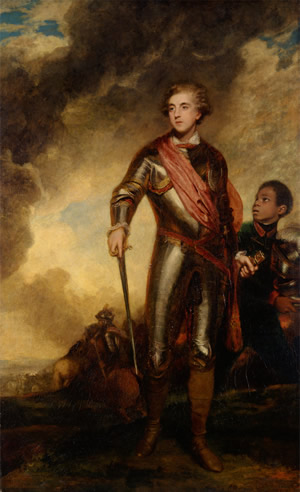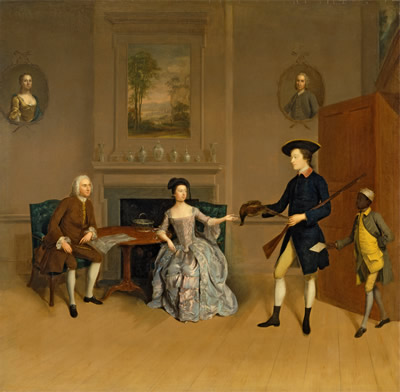
On November 7 and 8, The Gilder Lehrman Center for the Study of Slavery, Resistance, and Abolition held its 16 Annual International Conference at the Yale Center for British Art, the culmination of extraordinary collaboration across Yale around the study of the visual culture of British slavery. The conference, Visualizing Slavery and British Culture in the Eighteenth Century, brought together scholars from across the country and Europe to analyze the relationships between slavery art, taste, and power. More than 150 people attended. The conference grew directly out of the YCBA’s current exhibition, Figures of Empire: Slavery and Portraiture in Eighteenth-Century Atlantic Britain.
Many of the works of art in the exhibition share common features – positioning, scenes, and subjects. Rarely, though, are the recurrent presence of servants in family and landscape portraits noticed, much less examined and interrogated as part of local and global systems of slavery. Figures of Empire places these figures at the center of not only 18th century British art, but also of the empire. The GLC conference, co-sponsored by the Yale Center for British Art and the Lewis Walpole Library, placed the works of art in historical, art historical, and cultural context.
After brief introductions by GLC Director David Blight and YCBA Associate Curator of Education Cyra Levenson, Yale history professor Steven Pincus kicked off the conference by examining the life and business of university namesake Elihu Yale, and what can be learned – about slavery, merchant capitalism, political institutions, status – from his portrait with a collared servant featured in the exhibition. Agnes Lugo-Ortiz and Geoff Quilley presented slavery and slaves in Atlantic and contemporary art. Such figures were not merely art tropes; slaves and free people of color lived in Britain in the 18th century. Yale African-American studies and history professor Edward Rugemer described the black community and the laws of slavery in Britain, while Yale drama professor Joseph Roach discussed the very popular stories of slavery on the London stage in the 18th century.
 Slavery’s existence in Britain, not only in its colonies, was reflected in its art, drama, literature, language, and artifacts. James Walvin and Chi-ming Yang discussed slavery in everyday and luxury products, while Vanderbilt history professor Catherine Molineux traced the development of British aesthetic responses to rise of the British slave trade. Nicole Aljoe, Saidiya Hartman, Roxann Wheeler and Nick Draper covered archives of slavery in literature, art, and history. Finally, Richard Rabinowitz, Wayne Modest, and Ken Gonzales-Day spoke about current efforts to reckon with slavery in art and history museums, and how contemporary artists use the history of slavery and objects, such as those in the exhibition, to inspire new works of art.
Slavery’s existence in Britain, not only in its colonies, was reflected in its art, drama, literature, language, and artifacts. James Walvin and Chi-ming Yang discussed slavery in everyday and luxury products, while Vanderbilt history professor Catherine Molineux traced the development of British aesthetic responses to rise of the British slave trade. Nicole Aljoe, Saidiya Hartman, Roxann Wheeler and Nick Draper covered archives of slavery in literature, art, and history. Finally, Richard Rabinowitz, Wayne Modest, and Ken Gonzales-Day spoke about current efforts to reckon with slavery in art and history museums, and how contemporary artists use the history of slavery and objects, such as those in the exhibition, to inspire new works of art.
Holding the conference at the YCBA afforded opportunities to create a truly interdisciplinary event. Curators led Figures of Empire exhibition tours. Additional sessions included tours of the Greek and American slave sculptures on display in the Sculpture Victorious exhibition, interactive classes utilizing YCBA’s contemporary collections, the story of the National Portrait Gallery’s rediscovery and display of the Diallo portrait, and a presentation about the Prospects of Empire: Slavery and Ecology in Eighteenth-Century Atlantic Britain exhibition currently on view at the Lewis Walpole Library.
A roundtable including Nell Painter, artist and Princeton professor of history emerita; Sandra Jackson-Dumont, Chair of Education at the Met; and Timothy Barringer, Yale professor of art history, concluded the conference by stressing the importance of the YCBA bringing these works of art and issues to light, and called for continued interrogation of the connections between slavery and visual culture.
